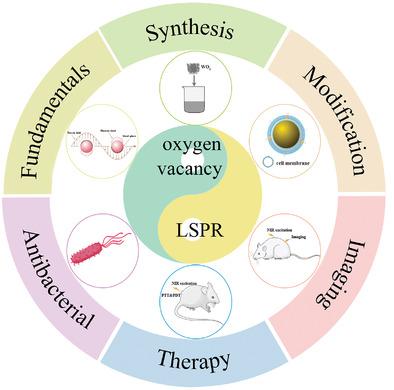当前位置:
X-MOL 学术
›
Adv. Healthcare Mater.
›
论文详情
Our official English website, www.x-mol.net, welcomes your
feedback! (Note: you will need to create a separate account there.)
Plasmonic Oxygen Defects in MO3−x (M = W or Mo) Nanomaterials: Synthesis, Modifications, and Biomedical Applications
Advanced Healthcare Materials ( IF 10.0 ) Pub Date : 2021-09-22 , DOI: 10.1002/adhm.202101331 Mingzhu Zhou 1 , Yachong Liu 1 , Yan Su 2 , Qianqian Su 1
Advanced Healthcare Materials ( IF 10.0 ) Pub Date : 2021-09-22 , DOI: 10.1002/adhm.202101331 Mingzhu Zhou 1 , Yachong Liu 1 , Yan Su 2 , Qianqian Su 1
Affiliation

|
Nanomedicine is a promising technology with many advantages and provides exciting opportunities for cancer diagnosis and therapy. During recent years, the newly developed oxygen-deficiency transition metal oxides MO3−x (M = W or Mo) have received significant attention due to the unique optical properties, such as strong localized surface plasmon resonance (LSPR) , tunable and broad near-IR absorption, high photothermal conversion efficiency, and large X-ray attenuation coefficient. This review presents an overview of recent advances in the development of MO3−x nanomaterials for biomedical applications. First, the fundamentals of the LSPR effect are introduced. Then, the preparation and modification methods of MO3−x nanomaterials are summarized. In addition, the biological effects of MO3−x nanomaterials are highlighted and their applications in the biomedical field are outlined. This includes imaging modalities, cancer treatment, and antibacterial capability. Finally, the prospects and challenges of MO3−x and MO3−x-based nanomaterial for fundamental studies and clinical applications are also discussed.
中文翻译:

MO3−x(M = W 或 Mo)纳米材料中的等离子体氧缺陷:合成、改性和生物医学应用
纳米医学是一种很有前途的技术,具有许多优点,为癌症的诊断和治疗提供了令人兴奋的机会。近年来,新开发的缺氧过渡金属氧化物MO 3− x(M = W或Mo)由于其独特的光学性质,如强局域表面等离子共振(LSPR)、可调谐和宽近-IR吸收,光热转换效率高,X射线衰减系数大。本综述概述了用于生物医学应用的 MO 3− x纳米材料开发的最新进展。首先,介绍了 LSPR 效应的基本原理。然后,MO 3− x的制备和改性方法纳米材料进行了总结。此外,重点介绍了MO 3− x纳米材料的生物学效应,并概述了它们在生物医学领域的应用。这包括成像方式、癌症治疗和抗菌能力。最后,还讨论了MO 3− x和 MO 3− x基纳米材料在基础研究和临床应用中的前景和挑战。
更新日期:2021-09-22
中文翻译:

MO3−x(M = W 或 Mo)纳米材料中的等离子体氧缺陷:合成、改性和生物医学应用
纳米医学是一种很有前途的技术,具有许多优点,为癌症的诊断和治疗提供了令人兴奋的机会。近年来,新开发的缺氧过渡金属氧化物MO 3− x(M = W或Mo)由于其独特的光学性质,如强局域表面等离子共振(LSPR)、可调谐和宽近-IR吸收,光热转换效率高,X射线衰减系数大。本综述概述了用于生物医学应用的 MO 3− x纳米材料开发的最新进展。首先,介绍了 LSPR 效应的基本原理。然后,MO 3− x的制备和改性方法纳米材料进行了总结。此外,重点介绍了MO 3− x纳米材料的生物学效应,并概述了它们在生物医学领域的应用。这包括成像方式、癌症治疗和抗菌能力。最后,还讨论了MO 3− x和 MO 3− x基纳米材料在基础研究和临床应用中的前景和挑战。











































 京公网安备 11010802027423号
京公网安备 11010802027423号